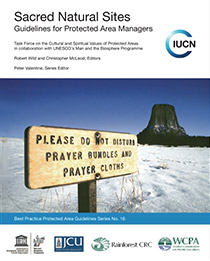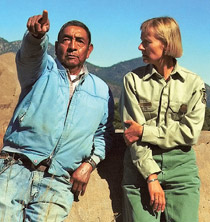IUCN UNESCO Guidelines for Protected Area Managers
These guidelines primarily assist protected area managers, especially those with sacred sites located within the boundaries of their legally established protected areas. However they are useful to a wider audience.
It would be inappropriate for IUCN or UNESCO (or any other organisations intervening from outside) to provide management advice regarding sacred sites without the permission and advice from the appropriate custodians. It is hoped that the guidelines will promote cooperation between protected area managers and custodians of sacred sites towards the enhanced conservation of these special places.
In their current form, the guidelines are relatively detailed and prescriptive. The 44 guidance points are grouped into six principles. In terms of flow, they generally develop from the specific and local to the more general and national level. The guidelines contain 16 case studies. The guidelines are available in English, Spanish, Estonian and Russian. Chinese and Japanese translations are under way. Volunteers are using the guidelines in protected areas and others currently translate the core guidelines into many more languages. You may do the same.
The Guidelines have been developed by the IUCN Specialist group on Cultural and spiritual Values of Protected Areas and edited by Robert Wild and Christopher McLeod under the Auspices of IUCN and UNESCO's Man and the Biosphere Programme. The Guidelines are Number 16 of the Best Practice Protected Area Guidelines Series produced by IUCN's World Commission on protected Areas which is edited by. Prof. Peter Valentine.
Whom are the guidelines meant for?
While managers of protected areas are the main focus for the guidelines, it is hoped that they will be of use to a wider group of stakeholders and policymakers. This advice is therefore aimed at:- Managers of individual protected areas with sacred natural sites located either within them or nearby;
- Mangers of protected areas systems who have scared natural sites within or in the sphere of influence of their network of protected areas;
- Natural resource ministries responsible for protected area agencies and systems.
- Planning authorities responsible for land-use planning and natural resource development outside protected areas;
- Traditional custodians who wish to engage with environmental or protected area authorities to increase the protection of their sacred sites, or seek or offer advice about ecological management;
- Non-government and other agencies that are providing support to the custodians of sacred natural sites;
- Other custodians, governments NGOs and industry that wish to support the conservation of sacred natural sites.
You can help test the guidelines!
We are looking for a range of government and community protected areas to test and review the Guidelines or to contribute case studies. These protected areas may cover different geographical areas and ecosystems representing a broad variety of cultures, faiths and spiritualities that manage sacred natural sites.
Testing the guidelines can be done in various ways depending on your ability to apply them in the management process. The guidelines can be tested as part of your day to day management activities based on which you can speak from experience. They can also be used to develop a deliberate process which is then implemented in the field or integrated in the management effectiveness monitoring cycle.
Reviewing the Guidelines
The guidelines are being reviewed and tested in order to to help conservation professionals and the custodians of sacred sites ensure the long-term survival of such valuable places, especially those that are now located in protected areas and Indigenous and Community Conserved areas.
If you are a protected area (PA) manager, a conservation professional, a custodian or guardian of a sacred natural site (SNS), a community person, a scientist or a decision maker working with SNS you can help improve the guidelines.
This review survey is based on the 44 "Essential Guidelines" presented in section 4 of the Guidelines publication and will take approximately 45 minutes.
Contribute a Case Study
Based on your own experience or expertise you may wish to contribute a case study or assist us with reviewing and testing the guidelines.
The guidelines currently feature 16 case studies that illustrate the usefulness of the guidelines in government and community protected areas.
To contribute a case study you can follow the examples of these provided in the Guidelines or contact us in case you are interested in contributing a more structured and elaborate case study.
We are currently working on a case study data basethat will allow custodians and conservation professionals to make use of the best information that can possibly be made available within the limits of appropriate cultural protocols.





